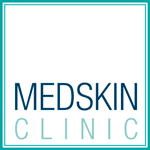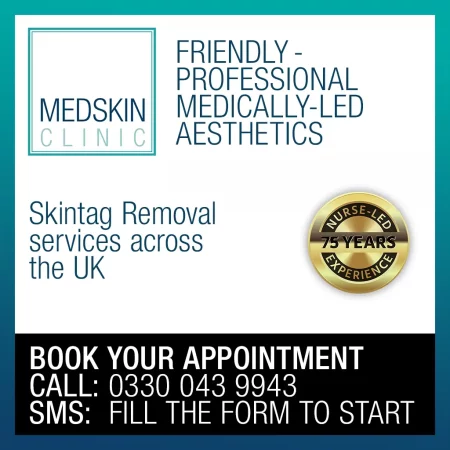FREE Consultation 0330 043 9943

Skin tag Removal Chester
Looking for Skin tag Removal in Chester
Skin Tag Removal Chester – At MedSkin Skin Tag Removal Chester, we are committed to offering professional and comprehensive treatments for common skin conditions such as moles, milia, and skin tags. These issues can impact both the physical and psychological health of an individual, causing discomfort and affecting self-image, thereby underscoring the importance of effective treatment options. Our services are available in Chester and surrounding areas.
Skin tags and warts are sometimes confused, but while both are generally non-painful and non-cancerous, warts are contagious and can spread, making specialist removal advisable.
Skin tags often appear in places like the neck, armpits, under the breasts, in the groin area, on the eyelids, or on the bottom. They are usually painless but can cause irritation if they rub or catch on clothing. Besides physical discomfort, skin tags may also be visually displeasing, leading to feelings of self-consciousness or embarrassment.
Here’s how you can distinguish between a skin tag and a wart:
- Skin tags are soft and smooth, whereas warts are rougher with a bumpy surface.
- Warts typically appear flat against the skin, while skin tags are raised and hang off the skin.
- Skin tags are non-contagious and usually isolated, unlike warts which are contagious and often appear in clusters.
Milia are small, white bumps caused by trapped keratin under the skin, mostly found on the face around the eyes and nose, and may require dermatological treatment if persistent.
Skin tags are benign skin growths that emerge in friction-prone areas like the neck and armpits. Though harmless, they can be bothersome and uncomfortable, making removal a consideration for many.
Which Treatment Is Right For You?
Skin Tag Removal Chester proudly provides a range of effective treatments for addressing moles, milia, and skin tags, helping you find the most suitable approach for your specific needs.
One of our premier treatments is the CryoPen, a state-of-the-art, minimally invasive device that uses liquid nitrogen to freeze and remove skin lesions accurately. This quick and efficient procedure involves a trained clinician using a precise probe to apply a controlled burst of liquid nitrogen. The affected tissue then naturally separates from the surrounding skin and falls off within weeks.
At Skin Tag Removal Chester, we do more than just offer advanced treatments; we support you in every step of your skincare journey. Our experienced team is ready to provide guidance, support, and high-quality care tailored to your individual needs.
We understand the importance of selecting the right treatment and are available to address any questions about our services. Whether you’re aiming to remove an annoying skin tag, address milia, or have a mole evaluated and treated, our focus is on ensuring a comfortable, safe, and positive outcome.
At the Skin Tag Removal Chester Clinic, your health, comfort, and satisfaction are our top priorities.
For more information or to schedule an appointment, please call us or fill out our contact form, and a member of our Skin Tag Removal Chester nursing staff will get back to you promptly.
Fill this Form to connect via SMS
What does Skin Tag Removal Treatment Involve?
What is a Skin Tag
A skin tag is a small, soft piece of skin that sticks out on a thin stalk. They’re common and harmless and can appear anywhere on the body. People often find them on the neck, underarms, around the groin, or under the breasts. Skin tags are made of loose collagen fibers and blood vessels surrounded by skin. They’re more common in older adults, people with certain health conditions, or those who are overweight. Skin tags don’t usually cause pain or discomfort, but they can be annoying. If someone doesn’t like how a skin tag looks or if it’s irritating, all skin tags can easily be removed.

Skin Tag Removal Chester Questions

What exactly are skin tags, and how do they form?
Skin tags are diminutive, non-cancerous protrusions that frequently emerge on parts of the body where skin comes into contact with other skin or clothes. They are usually without pain and not harmful, though at times they may lead to irritation or unease if they snag on clothing or Jewellery.
When is it advised to remove skin tags?
The recommendation for removing skin tags often arises for aesthetic reasons or if the tags lead to discomfort because of their position or size. Although skin tags are typically benign, their removal might be deemed necessary if they become irritated, start to bleed, or if there’s concern they might indicate a more grave health issue.
There could be many reasons why you’d want to remove a cyst. Common reasons may include disliking its appearance, experiencing discomfort due to its size or location (such as when brushing your hair, wearing certain clothes or Jewellery, or shaving), inflammation, the sudden growth of the cyst, its tenderness or itchiness, or if it has burst, leaked, developed an abscess. As they grow larger, cysts are likelier to rupture and cause discomfort, making earlier removal when they’re smaller much simpler.
What are the various techniques for removing skin tags?
Excision
Excision is the process of removing the skin tag using a scalpel or scissors after applying a local anaesthetic to numb the area. This technique is particularly effective for removing larger skin tags or those in delicate areas.
Cryotherapy
Cryotherapy entails the application of liquid nitrogen to freeze the skin tag, leading it to detach over time. Suitable for smaller skin tags, this approach might necessitate several sessions to achieve full removal.
Ligation
Ligation involves constricting the base of the skin tag with a piece of thread or suture, thus halting its blood flow and causing it to eventually drop off. While less frequently employed, this technique can be effective for larger tags.
What can patients anticipate during a skin tag removal process?
Consultation
Prior to the procedure, patients will undergo a consultation with their healthcare practitioner to discuss the most suitable method for removal, along with any potential risks or complications that may arise.
Procedure
Throughout the procedure, the surrounding area of the skin tag will be cleansed, and local anaesthetic might be administered to desensitise the area. Subsequently, the chosen method for removing the skin tag will be conducted, leading to the removal of the skin tag.
Aftercare
Following the procedure, it’s common for patients to experience slight discomfort or redness at the site of removal. You will receive instructions to maintain the area clean and dry and to refrain from touching or aggravating the area.
While removing skin tags is predominantly safe, several risks and potential complications should be considered, such as:
Bleeding: There can be some bleeding during or following the procedure, notably with methods like excision.
Infection: The area where the skin tag was removed is at risk of infection, especially if the aftercare guidelines are not adhered to properly.
Scarring: There is a possibility of scarring at the site of removal, particularly with techniques such as excision or if the site is not cared for appropriately after the procedure.
The time it takes to recover after having a skin tag removed can differ based on the removal technique used and the individual’s capacity for healing. Typically, most patients may find that the area will heal in anything from a few days to a couple of weeks. Adhering to any aftercare guidance given by the healthcare professional is crucial to ensure a smooth healing process and to reduce the likelihood of any complications.
The removal of skin tags is a routine and generally straightforward procedure that can enhance both physical comfort and self-esteem. By gaining knowledge about the various methods of removal, understanding potential risks, and comprehending the aftercare necessities, patients can make informed choices regarding their skin health and welfare. If you have any issues about skin tags or if you’re contemplating having them removed, it’s advisable to seek tailored advice and treatment options from your healthcare provider.
We also offer Wart Removal

Book your free consultation now
We provide FREE, no-obligation consultations at our clinics to discuss your goals and to explore your treatment options.
